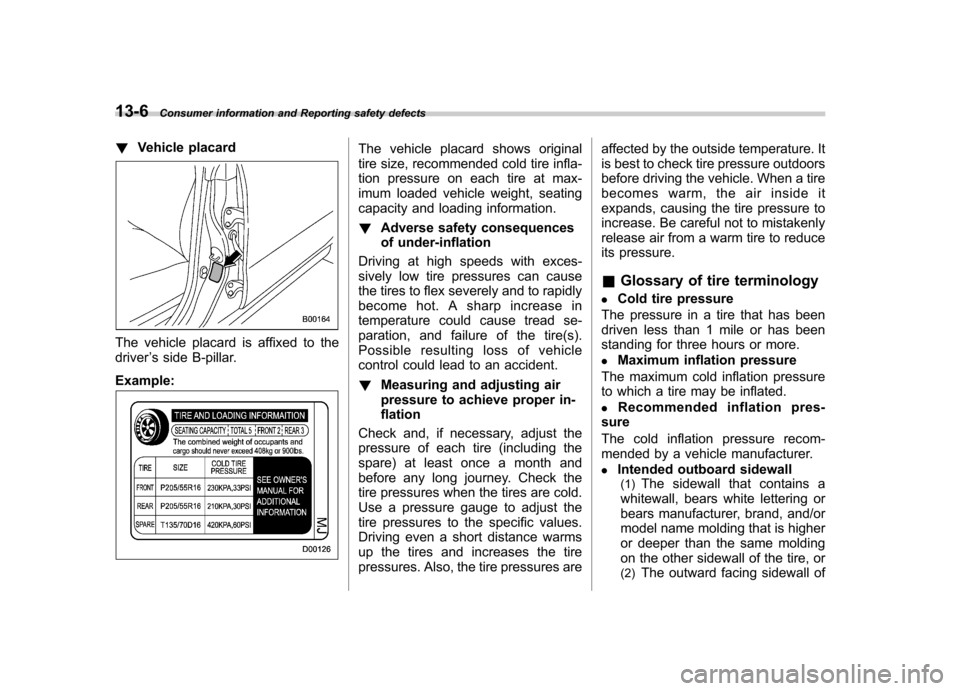tire pressure SUBARU IMPREZA WRX 2007 3.G Owner's Manual
[x] Cancel search | Manufacturer: SUBARU, Model Year: 2007, Model line: IMPREZA WRX, Model: SUBARU IMPREZA WRX 2007 3.GPages: 364, PDF Size: 11.91 MB
Page 346 of 364

13-6Consumer information and Reporting safety defects
! Vehicle placard
The vehicle placard is affixed to the driver ’s side B-pillar.
Example:
The vehicle placard shows original
tire size, recommended cold tire infla-
tion pressure on each tire at max-
imum loaded vehicle weight, seating
capacity and loading information. ! Adverse safety consequences
of under-inflation
Driving at high speeds with exces-
sively low tire pressures can cause
the tires to flex severely and to rapidly
become hot. A sharp increase in
temperature could cause tread se-
paration, and failure of the tire(s).
Possible resulting loss of vehicle
control could lead to an accident. ! Measuring and adjusting air
pressure to achieve proper in-
flation
Check and, if necessary, adjust the
pressure of each tire (including the
spare) at least once a month and
before any long journey. Check the
tire pressures when the tires are cold.
Use a pressure gauge to adjust the
tire pressures to the specific values.
Driving even a short distance warms
up the tires and increases the tire
pressures. Also, the tire pressures are affected by the outside temperature. It
is best to check tire pressure outdoors
before driving the vehicle. When a tire
becomes warm, the air inside it
expands, causing the tire pressure to
increase. Be careful not to mistakenly
release air from a warm tire to reduce
its pressure. &
Glossary of tire terminology
. Cold tire pressure
The pressure in a tire that has been
driven less than 1 mile or has been
standing for three hours or more. . Maximum inflation pressure
The maximum cold inflation pressure
to which a tire may be inflated. . Recommended inflation pres-
sure
The cold inflation pressure recom-
mended by a vehicle manufacturer. . Intended outboard sidewall
(1) The sidewall that contains a
whitewall, bears white lettering or
bears manufacturer, brand, and/or
model name molding that is higher
or deeper than the same molding
on the other sidewall of the tire, or (2) The outward facing sidewall of
Page 347 of 364

an asymmetrical tire that has a
particular side that must always
face outward when mounting on a
vehicle.
. Accessory weight
The combined weight (in excess of
those standard items which may be
replaced) of floor mats, leather seats
and cross bars to the extent that these
items are available as factory-in-
stalled equipment (whether installed
or not). . Curb weight
The weight of a motor vehicle with
standard equipment including the
maximum capacity of fuel, oil, and
coolant and air conditioning. . Maximum loaded vehicle weight
The sum of curb weight, accessory
weight, vehicle capacity weight and
production options weight. . Normal occupant weight
150 lbs (68 kg) times the number of
occupants (3 occupants). . Occupant distribution
Distribution of occupants in a vehicle,
2 in front, 1 in rear seat. .
Production options weight
The combined weight of those in-
stalled regular production options
weighing over 5.1 lbs (2.3 kg) in
excess of those standards items
which they replace, not previously
considered in curb weight or acces-
sory weight. . Vehicle capacity weight
The total weight of cargo, luggage
and occupants that can be added to
the vehicle. . Vehicle maximum load on a tire
Load on an individual tire that is
determined by distributing to each
axle its share of the maximum loaded
vehicle weight and dividing by two. . Vehicle normal load on a tire
Load on an individual tire that is
determined by distributing to each
axle its share of the curb weight,
accessory weight, and normal occu-
pant weight and dividing by two. & Tire care –maintenance and
safety practices
. Check on a daily basis that the tires
are free from serious damage, nails,
and stones. At the same time, check the tires for abnormal wear. .
Inspect the tire tread regularly and
replace the tires before their tread
wear indicators become visible. When
a tire ’s tread wear indicator becomes
visible, the tire is worn beyond the
acceptable limit and must be replaced
immediately. With a tire in this condi-
tion, driving at even low speeds in wet
weather can cause the vehicle to
hydroplane. Possible resulting loss
of vehicle control can lead to an
accident. . To maximize the life of each tire
and ensure that the tires wear uni-
formly, it is best to rotate the tires
every 7,500 miles (12,500 km). Rotat-
ing the tires involves switching the
front and rear tires on the right-hand
side of the vehicle and similarly
switching the front and rear tires on
the left-hand side of the vehicle.
(Each tire must be kept on its original
side of the vehicle.) Replace any
damaged or unevenly worn tires at
the time of rotation. After tire rotation,
adjust the tire pressures and make
sure the wheel nuts are correctly
tightened. A tightening torque specifi-
Consumer information and Reporting safety defects
13-7
– CONTINUED –
Page 361 of 364

14-8Index
Specifications ............................................................ 12-2
Speedometer ....................................................... 3-7, 3-11
SRS
Frontal airbag ........................................................ 1-39
Side airbag ........................................................... 1-50
SRS airbag (Supplemental Restraint System airbag) ... 4, 1-35
SRS airbag system
Monitors. ............................................................... 1-55
Servicing ............................................................... 1-56
Warning light ......................................................... 3-14
Starting the engine ....................................................... 7-7
State emission testing (U.S. only) .................................. 7-5
Steering wheel
Power ................................................................... 7-20
Tilt ....................................................................... 3-35
STI front lip spoiler ..................................................... 8-28
Stopping the engine ..................................................... 7-8
Storage compartment ................................................... 6-4
Sun shade ................................................................ 2-26
Sun visors ................................................................... 6-3
Supplemental Restraint System airbag (SRS) ................ 1-35
Synthetic leather upholstery ........................................ 10-5
T
Tachometer ......................................................... 3-7, 3-12
Temperature gauge .............................................. 3-8, 3-13
Temperature warning light (AT OIL TEMP) ..................... 3-17
Temporary spare tire .................................................... 9-2
Tie-down hooks ......................................................... 9-12
Tilt steering wheel ...................................................... 3-35 Tire
Chains .................................................................. 8-11
Inspection ............................................................ 11-30
Pressures and wear .............................................. 11-31
Replacement. ....................................................... 11-34
Rotation .............................................................. 11-34
Tires ......................................................................... 12-5
Types .................................................................. 11-30
Tires and wheels ...................................................... 11-30
Top tether anchorages ................................................ 1-32
Towing ...................................................................... 9-11
All wheels on the ground ......................................... 9-14
Flat-bed truck ......................................................... 9-13
Tie-down hooks ...................................................... 9-12
Weight .................................................................. 8-20
Trailer
Hitch ..................................................................... 8-17
Hitches .................................................................. 8-23
Towing .................................................................. 8-20
Towing tips ............................................................ 8-25
Trunk lid .................................................................... 2-20
Release handle ...................................................... 2-21
Trunk light ............................................................... 11-52
Turn signal Indicator lights ........................................................ 3-20
Lever .................................................................... 3-24
U
Under-floor storage compartment .................................. 6-12
Page 364 of 364

GAS STATION REFERENCE
& Fuel:
! 2.5-liter non-turbo models
Use only unleaded gasoline with an octane rating of 87 AKI or
higher. ! WRX
Use premium unleaded gasoline with an octane rating of 91 AKI
or higher. If premium unleaded gasoline with an octane rating of
91 AKI is not available, regular unleaded gasoline with octane
rating of 87 AKI or higher may be temporarily used. For
optimum engine performance and driveability, it is required that
you use premium grade unleaded gasoline with an octane
rating of 91 AKI or higher. ! WRX-STI
Use super-premium unleaded gasoline with an octane rating of
93 AKI or higher. If super-premium unleaded gasoline with an
octane rating of 93 AKI is not available, premium unleaded
gasoline with octane rating of 91 AKI or higher may be
temporarily used. For optimum engine performance and driveability, it is required that you use super-premium grade
unleaded gasoline with an octane rating of 93 AKI or higher.
& Fuel octane rating
This octane rating is the average of the Research Octane and
Motor Octane numbers and is commonly referred to as the Anti
Knock Index (AKI). Refer to “Fuel ”section in this manual.
& Fuel capacity
15.9 US gal (60 liters, 13.2 Imp gal) & Engine oil:
Use only API classification SM with the words “ENERGY
CONSERVING ”and the ILSAC certification mark (starburst
mark) displayed on the container. & Engine oil capacity:
4.2 US qt (4.0 liters, 3.5 Imp qt)
& Cold tire pressure:
Tire size P205/55R16 89V 215/45R17 91W 225/45R17 90W
Wheel size 16 66
1/2JJ 17 67JJ 17 68JJ
Pressure Front 33 psi (230 kPa, 2.3 kgf/cm
2) 33 psi (230 kPa, 2.3 kgf/cm2) 35 psi (240 kPa, 2.4 kgf/cm2)
Rear 30 psi (210 kPa, 2.1 kgf/cm
2) 32 psi (220 kPa, 2.2 kgf/cm2) 29 psi (200 kPa, 2.0 kgf/cm2)
Temporary
spare tire Size
T135/70 D16 T135/70 D17
Pressure 60 psi (420 kPa, 4.2 kgf/cm
2)